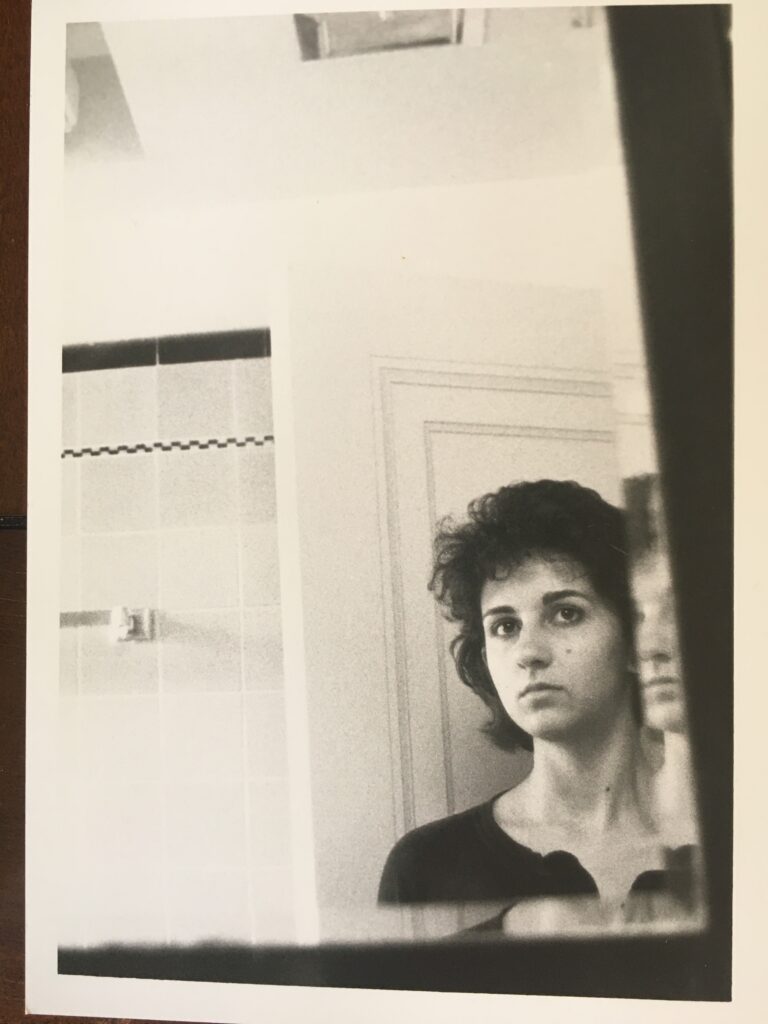CEC WEEKLY TIES – Toward Consider Culture
Feb. 4, 2021
Dear colleagues,
Cleaning out all the boxes my mother has been saving since my elementary school years took much of my December break. That is how I discovered this photograph from the 1980s, when I was an architecture student at Carnegie Mellon University. Taken long before the selfies’ era, it reminded me of stories in my research that solidified the power of the mirror to both collapse and expand a person’s ability to construct and define their identity, complicating how meaning-making in the home is understood and studied – see below.

A mirror never lies, we were led to believe growing up with Snow White’s Evil Queen, who every day asked the mirror, “Magic Mirror on the wall, Who is the fairest one of all?” Mirrors reflect everything and hide nothing, with their impartial reflection being a construct of reality that shows us what lies in front of us, helping us focus on the present and recognize what can be done to bring about change.
As the pandemic and the global call for social and racial justice ask of us to pause and reflect,
Let us call on the power of the mirror to help us regain control and entice us to move toward
Consider Culture.
Consider is the first leadership principle in CAST – Through Consider, Act, Seek, and Transform one can cast Culturally Enriched Communities. Consider Culture implies being intentional in reflecting on viewpoints that are radically different from one’s own. Acknowledging that often, meaning-making choices are bounded by stereotypes, systemic exclusion, and lack of opportunity, Consider Culture cultivates an intellectual platform that supports and encourages wonder and understanding. Consider Culture sparks curiosity and prompts us to ask:
- Who am I, how did I come to be, and who do I want to become?
- What could I be missing? And, how could I better understand?
Look forward to finding out what the mirror revealed to you.

Tasoulla Hadjiyanni, Founding Director
tasoulla@umn.edu
Madison’s story from The Right to Home

“As a single Black woman, Madison could see in the mirror the varying stereotypes she had to navigate and the choices she had to make in declaring her identity and stance…..
The mirror does not lie though and every time she looked at herself, Madison was reminded about the most prominent stereotype she had to circumvent, the myth of being a superwoman, which presents African American women as strong, independent, dominant, and capable of achieving anything……
Embracing the identity of a superwoman is often a way for many African American women to signal their commitment to provide for their family. Little is known however, about the toll this refusal to acknowledge vulnerability and suppress signs of physical or emotional distress takes on the well-being of African American women. Non-Hispanic Blacks were found to be significantly more likely to report major depression than non-Hispanic Whites (4.0 percent versus 3.1 percent) and women overall, were significantly more likely than men to report major depression (4.0 percent versus 2.7 percent) (CDC, 2010). According to the U.S. Department of Health and Human Services (2011) however, just 7.6 percent of African Americans sought treatment for depression compared to 13.6 percent of the general population in 2011.”
Excerpt from The Right to Home – Chapter 7 – African American Stories, pp. 247-248.
Dress and place in sex trafficking

“Mirrors were used to take a selfie for almost half of the images in the sample. Part of the reason could be its ability to display one’s self, something that comes handy when the goal is to solicit customers for sex. In the mirror, self and place blend and become one, albeit in an immaterial world, a reflection. Transcending the lived reality of the victim/subject, the mirror allows for the private to become a public marketing tool.
Selfies are now produced in unprecedented quantities, normalized through the availability of technology and social media–everyone, from ordinary citizens to celebrities and politicians publicize selfies as mediums for constructing their own representational narratives. Anthropological inquiry into the meaning of selfies points to their role in self-making. According to Shipley (2015: 407): “Taking selfies in the mirror creates another type of critical doubling of the self that works as a form of unintentional inversion. It collapses the sitter and the artist and then resplits them into oppositional, mirror images, creating a form of self recognition that is at the same time alienating.”
Understandings of the selfie multiply when the purpose behind the image is to transform a human body into a commodity that is for sale. Selfies that embody popular imagery, such as Kim Kardashian’s selfies, to elicit sexuality challenge the agency of the person involved to craft their own story and relate their own memoir. For victims of trafficking, the illusion of the self that is created in the mirror can provide a “safe” distance between the “real” self and the one that is sold. “Alienation” in these cases provides a method to protect levels of identity that are being stripped away. Theorizing mirrors as an element of interiors that can both collapse and expand a person’s ability to construct and define his/her identity can complicate how trafficking is understood and studied.”
Excerpt from “Dress and place in sex work– Attracting customers through virtual environments” in Annette Lynch & Katalin Medvedev (Eds), Fashion, agency, and empowerment: Performing agency, following script.
Original image: Backpage.com
